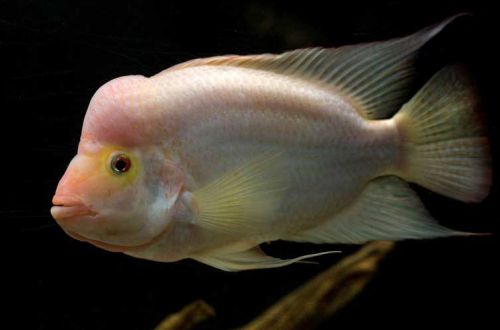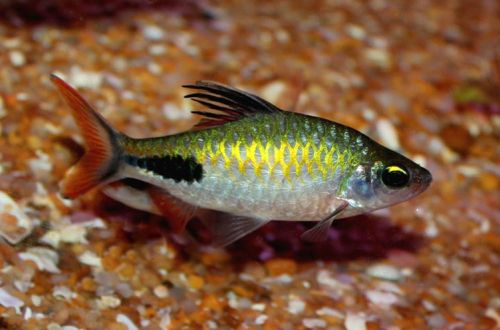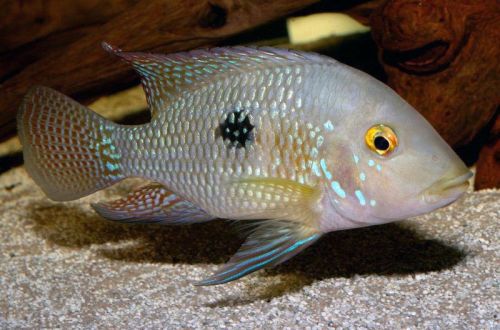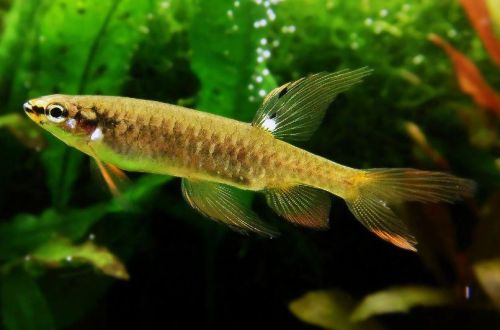
Cichlid Midas
The Midas cichlid or Citron cichlid, scientific name Amphilophus citrinellus, belongs to the Cichlidae family. The fish got one of its names in honor of King Midas and the legend associated with him, in which he appears as a cruel and greedy tyrant. If you look closely at the behavior of this species of cichlids, then there is a certain similarity. The fish is extremely belligerent and aggressive, including towards its relatives, and is also distinguished by exorbitant voracity.

Contents
Habitat
It comes from Central America from the territory of Nicaragua and Costa Rica. Inhabits permanent lakes, ponds, backwaters of rivers with calm water. The type of terrain is characterized by rocky and limestone soils, respectively, the reservoirs have a rocky bottom with a rugged coastline and numerous gorges and grottoes.
Brief information:
- The volume of the aquarium – from 400 liters.
- Temperature – 21-26°C
- Value pH — 6.0–8.0
- Water hardness – 5–26 dGH
- Substrate type – sandy, rocky
- Lighting – moderate
- Brackish water – no
- Water movement – little or no
- The size of the fish is 30–35 cm.
- Food – any food
- Temperament – aggressive
- Keeping alone in a species aquarium
Description

Adults reach a length of 30-35 cm. Outwardly, it resembles its closest relative, the Red Devil cichlid (endemic to Lake Nicaragua), which were once one species and split relatively recently – only about 10 years ago. Outwardly, they are practically indistinguishable, but they are not capable of crossing. Depending on the specific region of origin, the color of the fish varies from pink to red or orange. Sexually mature dominant males have an impressive “hump” on their heads. It is absent in females. Otherwise, sexual dimorphism is weakly expressed.
Food
The harsh habitat among rocky formations with scarce food resources predetermined the diet of this species. The Midas cichlid will eat anything it can fit in its mouth, so there will be no problem choosing the right food. It is advisable to use a variety of products (dry, live, frozen) with mandatory herbal supplements. The latter can already be included in the feed, for example, in dry granules, or served separately – spirulina flakes, pieces of lettuce, spinach, vegetables.
Fish do not know the feeling of fullness, so the number of meals and the amount of food must be limited. Feed 2-3 times a day in the amount eaten in 5 minutes.
Maintenance and care, arrangement of the aquarium
The size of the aquarium depends entirely on the number of fish planned for keeping. Given the size of adults and the hostile attitude towards relatives, one Cichlaz and citron will require a tank of at least 400 liters, for two – already more than 800, etc.
This fish is not for a beautifully decorated aquarium. Most of the decorative elements of the design will be broken, turned inside out, displaced. It is allowed to use only large fragments of rocks, large stones and snags, sand and gravel substrate. Plants are excluded, they will quickly be exterminated. If two or more fish are kept, no matter what species, the maximum number of visual barriers and shelters should be provided.
Protection will require internal equipment and devices (heaters, aerators, nozzles, thermometers, etc.), they must be securely fixed and located in such a way that the fish cannot get close to them.
A large role in maintaining stable water conditions is assigned to the filtration system from external filters. Equally important is the weekly replacement of part of the water with fresh water and regular cleaning of the aquarium from organic waste (food residue, excrement).
Behavior and Compatibility
It is considered one of the most warlike cichdlids. In a small volume (about 300 liters) there should be only one fish. In large tanks from 1000 liters, 2-3 Midas cichlids can be in relative safety for each other. It is acceptable to keep together with other large fish.
Breeding / breeding
Breeding will not be difficult if there is an established male/female pair available. In all other cases, obtaining offspring is unlikely. This type of cichlid has complex behavioral features. If the male is kept alone, then the female sharing with him for the purpose of reproduction will only lead to her death, since she will be perceived not as a partner, but as a rival.
Pairing is a lengthy process. The fish themselves find each other from among those with whom they grew up together from a young age for several years. For example, there is a small chance that one pair will appear from a group of 5-6 fish, but there is no guarantee. The formation of a pair of already adult fish does not occur.
During the mating season, the male and female, ready for mating, begin mutual courtship, which can be quite lengthy and sometimes more like a duel with tail blows, pushes to the side, etc. Spawning occurs on any even, dense surface – a flat stone. The fry appear already on the 2nd or 3rd day and are transferred by caring parents to a pre-dug hole at the bottom. Both parents protect the offspring from any potential danger. If during this period you start cleaning the aquarium, then the male will attack the hand of the aquarist. After about a week, the fry begin to swim freely.
Fish diseases
The main cause of diseases lies in the conditions of detention, if they go beyond the permissible range, then immunity suppression inevitably occurs and the fish becomes susceptible to various infections that are inevitably present in the environment. If the first suspicions arise that the fish is sick, the first step is to check the water parameters and the presence of dangerous concentrations of nitrogen cycle products. Restoration of normal/suitable conditions often promotes healing. However, in some cases, medical treatment is indispensable. Read more about symptoms and treatments in the Aquarium Fish Diseases section.





